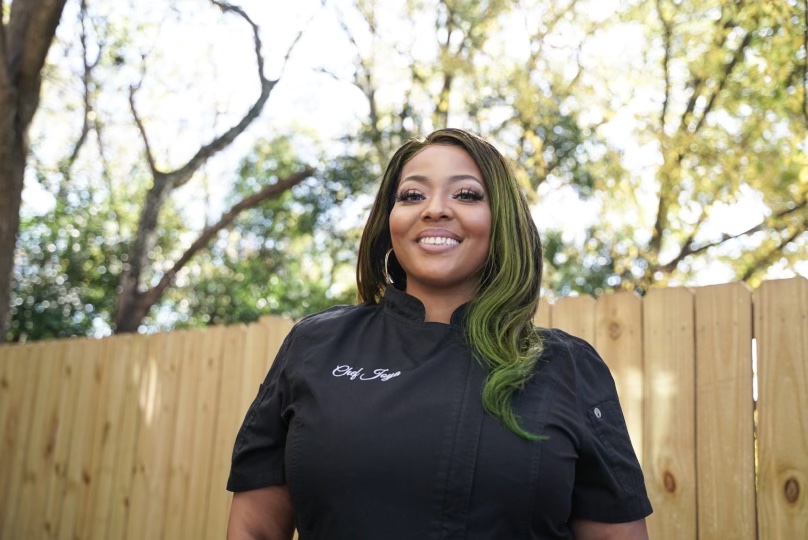The popularity of veganism in the Black community has risen in recent years. According to a 2016 study from Pew Research Center, Black vegans and vegetarians are the fastest growing demographic in the United States. There are many ways to turn traditional African, Caribbean and Black southern cuisine into vegan dishes. Adjoa Courtney, known professionally as Chef Joya, is teaching the community how to do exactly that.
Courtney is creating a lane for herself in the culinary world as a vegan tastemaker. Her passion for turning basic recipes into mouth-watering dishes has turned her Brunchin’ With Joya monthly brunch pop-up series into a sensation.
Although she was raised as a vegan, Courtney spent time eating non-vegan foods as a young adult. This time helped her develop ways to “veganize” popular traditional dishes, like macaroni and cheese, filet mignon and sweet potato pie.

The Midwest chef now resides in Charlotte, North Carolina, and travels the country exposing people to ways to implement vegan dishes in their diets without compromising on taste. Travel Noire had the chance to chat with Chef Joya about her career journey from being a makeup artist to a chef, tips for going vegan and how you can “veganize” your favorite dishes.
Travel Noire: What inspired you to start a career as a chef after being a professional makeup artist for over a decade?
Adjoa Courtney: My friends and my family inspired me.
I would always host dinner parties for them because I loved to cook and create art at the same time. For years, they said, “you need to open a restaurant,” but I never wanted to work for someone else. It wasn’t until I met Chef Lisa Brooks, a Charlotte-based personal chef, that I learned that I could make a career out of doing what I truly love to do.
TN: You grew up vegan, but spent years eating meat and dairy as an adult. How did those years of being non-vegan impact the food you cook as a vegan chef?
AC: I believe those years were very crucial to my skill level as a vegan chef. I was a huge foodie and always wanted to know the why’s and how’s of food.
I believe food has a story to tell, and the textures and flavors are crucial in telling those stories. Being non-vegan for years allowed me to try authentic foods from all over and understand how they should look, taste and smell. When I came back over to the green side, I wanted to capture those same essences for nostalgic purposes. I didn’t know it at the time, but doing that is what sets me apart from every other vegan chef.
TN: What inspired your move from Milwaukee to Charlotte?
AC: I wanted to leave Milwaukee because I wanted to raise my sons in a safer environment. My brothers had also moved to Charlotte, and I felt that they would be great male role models.
TN: What is your favorite southern dish to make vegan?
AC: It’s funny that you ask because I don’t have a favorite thing to make. I’m most known for my vegan baked mac and cheese.
TN: Can you share tips for meat eaters wanting to go vegan, but don’t know where to start?
AC: Start slowly by eliminating one [non-vegan] meal per day and replacing it with a similar vegetarian or vegan substitute. Then eliminate and replace a second, a third and so on. This gives you time to explore and learn about the various vegan options and vegan substitutes that are available, which can help lead you to discover one or multiple items that you really enjoy.
Learn how to recreate the meals you love now. Intense cravings for meals you love are the cause of slip ups.
Know why you’re doing it in the first place and keep that at the forefront. Sometimes we go on this journey, and it can become too much for some that they forget why they started in the first place. Getting discouraged is sometimes a part of it, so when you think about why you’re doing it in the first place, it gives you the necessary bump up that you need to keep going.
TN: How can those from African, Caribbean or Black southern culture incorporate veganism into their traditional foods?
AC: Learn to capture those same flavors through seasonings, bouillons and trying different products. It’s really easy to make whatever it is that you love vegan. If you can’t cook, have your grandma and auntie do it. Make sure you buy the right substitute ingredients and watch them.
TN: What are your favorite cities around the world for vegan food?
AC: Chicago. That’s it, [and] that’s all. I’m sure if I go to Ethiopia or Thailand, I would love those as well.
Keep up with Chef Joya’s journey on her website, Instagram, Facebook, TikTok, and YouTube.
This article has been edited and condensed for length and clarity.




